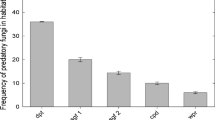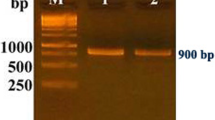Abstract
The spread of organic farming and the development of resistance to anthelmintics by parasites, especially in small ruminants, have necessitated the search for alternative methods of nematode control. Biological control using nematophagous fungi is one option; however, few studies have been conducted with native strains. The present study was divided into two phases. In the first phase, we aimed to isolate, identify, and assess the in vitro predatory activity of nematophagous fungi that had been isolated on Trichostrongylidae third-instar larvae. In the second phase, the isolate with superior predatory activity in vitro was molecularly characterized, and its morphological plasticity was observed using scanning electron microscopy (SEM) on Haemonchus third-instar larvae. Of the 56 soil samples from different regions of Paraná State, Brazil, 57 fungal strains were recovered, of which four exhibited predatory activity. Two pure isolates were obtained: the CED and LIN strains. After demonstrating 96.35 % predatory activity for the CED strain, this strain was selected and characterized using molecular criteria by sequencing the rDNA internal transcribed spacer and was identified as Arthrobotrys conoides (GenBank ID: JN191309). Morphological patterns in this strain during the interaction between the fungus and the nematode were revealed by SEM, in which two extensions of the infection bulb that was used to pierce the nematode's cuticle were clearly visible.



Similar content being viewed by others
References
Araújo JV, Santos MA, Ferraz S, Maia AS (1994) Biological control “in vitro” of infective Haemonchus placei larvae by predacious fungi Arthrobotrys musiformis. Arq Bras Med Vet Zoot 46:197–204
Araújo JV, Campos AK, Paiva F, Vieira-Bressan MCR (2001) Efeito antagonista de fungos predadores do gênero Arthrobotrys sobre larvas infectantes de Oesophagosthomum radiatum, Cooperia punctata e Haemonchus placei. (Antagonistic effect of fungal predators from the Arthrobotrys genus on infective larvae of Oesophagosthomum radiatum, Cooperia punctata and Haemonchus placei.). Rev Bras Cienc Vet 8:81–84
Braga FR, Silva AR, Carvalho RO, Araújo JV, Guimarães PGC, Fujiwara RT, Frassy LN (2010) In vitro predatory activity of the fungi Duddingtonia flagrans, Monacrosporium thaumasium, Monacrosporium sinense, Arthrobotrys robusta on Ancylostoma celanicum, third-stage larvae. Vet Microbiol 146:183–186
Campos AK, Araújo JV, Guimarães MP (2008) Interactions between the nematophagous fungus Dunddingtonia flagrans and infective larvae of Haemonchus contortus (Nematoda: Trichostrongyloidea). J Helminth 82:337–341
Chandrawathani P, Jamnah O, Adnan M, Waller PJ, Larsen M, Gillespie AT (2004) Field studies on the biological control of nematode parasites of sheep in the tropics, using the microfungus Duddingtonia flagrans. Vet Parasitol 120:177–187
Cooke RC, Godfrey BES (1964) A key of nematode-destroying fungi Trans. Brit Mycol Soc 47:61–74
Cruz DG, Araújo FB, Molento MB, DaMatta RA, Santos CP (2011) Kinetics of capture and infection of infective larvae of trichostrongylides and free-living nematodes Panagrellus sp. by Duddingtonia flagrans. Parasitol Res 109:1085–1091
Dalla Pria M, Ferraz S, Muchovej JJ (1991) Isolamento e identificação de fungos nematófagos de amostras de solo de diversas regiões do Brasil. (Isolation and identification of nematophagous fungi in soil samples from different regions of Brazil). Nematol Bras 19:170–177
Duddington CL (1955) Notes on the technique of handling predacious fungi. Trans Brit Mycol Soc 38:97–103
Dupponois R, Amadou MB, Matteile T (1998) Effect of some rhizospher bacteria for the biocontrol of nematodes of the genus Meloidogyne with Arthrobotrys oligospora. Fund Appl Nematol 2:157–163
Echevarria FAM, Borba MFS, Pinheiro AC, Waller PJ, Hansen JW (1996) The prevalence of anthelmintic resistance in nematode parasites of sheep in Southern Latin America: Brazil. Vet Parasitol 62:199–206
Epe C, Holst C, Koopmann R, Schnieder T, Larsen M, Von Samson-Himmelstjerna G (2009) Experiences with Duddingtonia flagrans administration to parasitized small ruminants. Vet Parasitol 159:86–90
Faedo M, Larsen M, Thamsborg S (2000) Effect of different times of administration of the nematophagous fungus Duddingtonia flagrans on the transmission of ovine parasitic nematodes on pasture—a plot study. Vet Parasitol 94:55–65
Fernandez AS, Larsen M, Henningsen E, Nansen P, Gronvold J, Bjorn H, Wolstrup J (1999) Effect of Duddingtonia flagrans against Ostertagia ostertagi in cattle grazing at different stocking rates. Parasitol 119:105–111
Gardner K, Wiebe MG, Gillispie AT, Trinci APJ (2000) Production of chlamydospores of the nematode-trapping Duddingtonia flagrans in shake flask culture. Mycol Res 104:205–209
Gerrits Van Den Ende AHG, Hoog GS (1999) Variability and molecular diagnostics of the neurotropic species Cladophialophora bantiana. Stud Mycol 43:151–162
Graminha EBN, Maia AS, Santos JM, Candido RC, Silva GS, Costa AJ (2001) Avaliação in vitro da patogenicidade de fungos predadores de nematóides parasitos de animais domesticos (In vitro assessment of pathogenicity of predatory fungi on parasitic nematodes of domestic animals). Sem Cienc Agr 22:11–16
Heintz CE (1978) Assessing the predacity of nematode trapping fungi in vitro. Mycol 70:1086–1100
Iapar (2009) Sistema de monitoramento agroclimático do Paraná. (Agro-climatic monitoring system of Paraná). Availableat: http://www.iapar.br/arquivos/Image/monitoramento/Medias_Historicas/Guarapuava.ht. Accessed on 08/10/2010.
Jukes TH, Cantor CR (1969) Evolution of protein molecules. In: Munro HN (ed) Mammalian protein metabolism. Academic, New York, pp 21–132
Kelly P, Good B, Hanharan JP, Fitzpatrick R, Wall TDT (2009) Screening for presence of nematophagous fungi collect from Irish sheep pastures. Vet Parasitol 165(3–4):345–349
Ketzis JK, Vercruysse J, Stromberg BE, Larsen M, Athanasiadou S, Houdijk JGM (2006) Evaluation of efficacy expectations for novel and non-chemical helminth control strategies in ruminants. Vet Parasitol 139:321–335
Larsen M (2006) Biological control of nematodes parasites in sheep. J An Sci 84:133–139
Maak R (1968) Geografia física do Estado do Paraná. Curitiba: Banco de Desenvolvimento do Estado do Paraná (Physical Geography of Paraná State). Development Bank of Paraná State, Curitiba, p 350
Maingi N, Krecek RC, Biljon NV (2006) Control of gastrointestinal nematodes in goats on pastures in South Africa using nematophagous fungi Duddingtonia flagrans and selective anthelmintic treatments. Vet Parasitol 138:328–336
Mankau R (1980) Biological control of nematode pests by natural enemies. Ann Rev Phytopathol 18:415–440
Manueli PR, Waller PJ, Faedo M, Mahommed F (1999) Biological control of nematode parasites of livestock in Fiji: screening of fresh dung of small ruminants for the presence of nematophagous fungi. Vet Parasitol 81:39–45
Mendonza-De-Gives P, Davies KG, Clark SJ, Behnke JM (1999) Predatory behavior of trapping fungi against of mutants of Caenorhabditis elegans and different plant and animal parasitic nematodes. Parasitol 119:95–104
Naves RL, Campos VP (1991) Ocorrência de fungos predadores de nematóides no sul de Minas Gerais e estudo da capacidade predatória e crescimento in vitro de alguns de seus isolados. (Presence of predatory fungi on nematodes in southern Minas Gerais state and the predatory capacity and in vitro growth of their isolates.). Nematol Bras 15:153–162
Nordbring-Hertz B (1983) Dialysis membrane technique for studying microbial interaction. Appl Environ Microbiol 45:399–407
Nordbring-Hertz B, Friman E, Veenhuis M (1989) Hyphal fusion during initial stage of trap formation in Arthrobotrys oligospora. Antonie Leeuwenhoek 55:237–244
Nordbring-Hertz B, Jansson HB, Tundlid, A (2002) Nematophagous fungi. In: Encyclopedia of Life Sciences. Macmillian Publishing Group/www.els.net. pp. 681–690.
Nordbring-Hertz B, Jansson HB, Tunlid A (2006) Nematophagous fungi. In: Encyclopedia of Life Sciences. John Wiley & Sons, Ltd., Chichester. doi:10.1038/npg.els.0004293, http://www.els.net/ pp1-1.
Oliveira RDL, Ferraz S, Alfenas AC, Dias-Arieira CR (2002) Caracterização morfológica e isoenzimática de espécies de Arthrobotrys ocorrentes no Brasil. (Morphological and isoenzyme characterization of Arthrobotrys species in Brazil). Nematol Bras 26:181–197
Philip J (2002) Nematophagous fungi: Guide by Philip Jacobs, BRIC-Version online. Accessed on: June/2008. Available at www.biological-research.com/.
Roberts FHS, O'Sullivan PJ (1950) Methods for egg counts and larval cultures for strongyles infecting tract of cattle. Austr J Agr 1:6–7
Saitou N, Nei M (1987) The neighbor-joining method: a new method for reconstructing phylogenetic trees. Mol Biol Evol 4:406–425
Santos MA, Ferraz S, Muchovej J (1991) Detection and ecology of nematophagous fungi from Brazilian soils. Nematol Bras 15:121–134
Sanyal PK (2000) Screening for Indian isolates of predacious fungi for use in biological control against nematode parasite of ruminants. Vet Res Commun 24:55–62
Saumell CA, Padilha T, Santos C, Roque MVC (1999) Nematophagous fungi in fresh feces off cattle in the Mata region in the Minas Gerais state. Brazil Vet Parasitol 82:217–220
Singh RK, Kumar N, Singh KP (2005) Morphological variations in Conidia of Arthrobotrys oligospora on different media. Mycobiol 33:118–120
Staden R (1996) The Staden sequence analysis package. Mol Biotech 5:233–241
Tamura K, Dudley J, Nei M, Kumar S (2007) MEGA 4: molecular evolutionary genetics analysis. Mol Biol Evol 24:1596–1599
Thomaz-Soccol V, Sotomaior C, Souza FP, Castro EA (1996) Occurrence of resistance to anthelmintics in sheep in Paraná State. Brazil Vet Rec 139:421–422
Thomaz-Soccol V, Souza FP, Sotomaior C, Castro EA, Milczewski V, Pessoa MC, Mocelin G (2004) Resistance of gastrointestinal nematodes of anthelmintics in sheep (Ovies aries). Braz Arch Biol Techn 47:41–47
Van Wyk JA, Cabaret J, Michael LM (2004) Morphological identification of nematode larvae of small ruminants and cattle simplified. Vet Parasitol 119:277–306
Wachira P, Mibey R, Okoth S, Kimenju J, Kiarie J (2009) Diversity of nematode destroying fungi in Taita Taveta. Kenya Fungal Ecol 2:60–65
Waller PJ (2006) From discovery to development: current industry perspectives for the development of novel methods of helminth control in livestock. Vet Parasitol 139:1–14
Waller PJ, Faedo M (1996) The prospects for biological control of the free-living stages of nematode parasites of livestock. Internat J Parasitol 26:915–925
Waller PJ, Schwann O, Ljungstro MBL, Rydzik A, Yeates GW (2004) Evaluation of biological control of sheep parasites using Duddingtonia flagrans under commercial farming conditions on the Island of Gotland. Vet Parasitol 126:299–315
Wang RB, Yang JK, Lin C, Zhang Y, Zhang KQ (2006) Purification and characterization of an extracellular serine protease from the nematode-trapping fungus Dactylella shizishanna. Lett Appl Microbiol 42:589–594
White TJ, Bruns T, Lee S, Taylor J (1990) PCR protocols: A guide to methods and applications. In: Innis MA, Gelfand DH, Sninsky JJ, White TJ (eds) Amplification and direct sequencing of fungal ribosomal RNA genes for phylogenetics. Academic Press, New York, pp 315–322
Author information
Authors and Affiliations
Corresponding author
Rights and permissions
About this article
Cite this article
Falbo, M.K., Soccol, V.T., Sandini, I.E. et al. Isolation and characterization of the nematophagous fungus Arthrobotrys conoides . Parasitol Res 112, 177–185 (2013). https://doi.org/10.1007/s00436-012-3123-3
Received:
Accepted:
Published:
Issue Date:
DOI: https://doi.org/10.1007/s00436-012-3123-3




